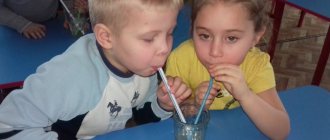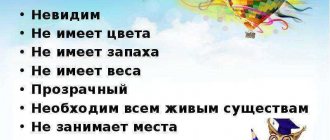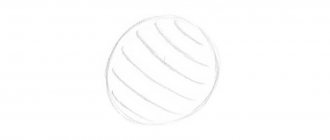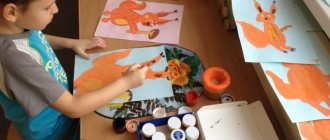Abstract of the GCD “Air is invisible”
Author - compiler:
Farrakhova Almira Khusnullovna,
teacher
"LG MADO" DSKV No. 8 "Ryabinka",
Langepas, Khanty-Mansiysk Autonomous Okrug, Tyumen region
annotation
Direct educational activities (hereinafter referred to as ECD) on the topic “Air is invisible” are built in the form of search and research activities, which allows you to maintain and develop the interest of children throughout the ECD, increases their cognitive activity, which facilitates the process of children’s assimilation of program material. In direct educational activities, the following tasks are set: to systematize and expand children’s knowledge about air, about its role in the world around them and to help children, through research activities, learn some properties of air, learn to establish cause-and-effect relationships between natural phenomena; develop your own cognitive experience, the ability to compare, generalize and draw conclusions.
The content of the methodological development is intended for children of senior preschool age.
Introduction
Relevance
Practice shows that many children have reduced motivation for the process of acquiring knowledge. In this regard, the need for the content of the education of preschoolers in search activities, which requires the use of knowledge and skills in a new situation for them, to solve new problems, becomes urgent. Search and research activity, as one of the elements of cognitive activity, helps to maintain and develop a child’s interest in research, promotes the development of perception, thinking, and most importantly - the development of speech, stimulates internal development and, to a certain extent, influences the personality as a whole. Cognitive activity is realized in activity. Therefore, it is important to create conditions and develop search and research activities with children.
The purpose and objectives of direct educational activities
The purpose of GCD: to deepen and systematize children’s ideas about air, as one of the main factors necessary for the existence of life on earth.
Educational objectives:
To provide basic knowledge about the natural element – air. Expand your understanding of the properties and role of air in the surrounding world. Show where and in what form air exists in the environment.
Developmental tasks: Develop thinking, the ability to establish cause-and-effect relationships between natural phenomena; develop your own cognitive experience, the ability to compare, generalize and draw conclusions.
Educational objectives: To foster interest in research activities; careful attitude towards natural resources and your health.
Methods and techniques: Conversation, story by characters and teacher, research games, outdoor game “Airplanes”, game with paper airplanes.
Developmental environment - “Mini-laboratory”: Balloons, a jar of water, a glass of water and a straw for each child, a tube for blowing soap bubbles, paper airplanes made in advance.
Progress of direct educational activities
Educator: Guys, who do you think is arguing outside the door? Let's get a look!
(They open the door and see Dunno and Znayka arguing there)
Educator. Hello! What happened, Dunno? What are you arguing about, Znayka?
Znayka. Dunno says that there is no air because no one sees it. And I say that I haven’t seen the air either, but I know that it is always around us.
Educator. Guys, what do you think?
Guys. Children's answers. (I can't see air either)
Educator. Guys, who agrees with Dunno and thinks that there is no air, stand next to him, and who agrees with Dunno, stand next to him.
Dunno. (addresses Znayka). I know, I know (mimicking him) - this is your favorite word. And I don't believe you. You prove that this very air is now in this room.
Znayka. Guys, help me! Let us together prove to Dunno that there is still air.
Educator. To prove that there is air around us, we need to go to our laboratory and do experiments. (Go to the laboratory)
(In the laboratory, children take places where all the equipment for experiments is prepared)
Znayka. (Picks up a glass.) Guys, do you think this glass is empty? Look carefully, is there anything in it? (Shows the glass to all the children in turn, listens to the answers, but does not evaluate them.)
Dunno. Well, why did you pester us with your glass! It is clear to everyone that there is nothing in him.
Znayka. (Smiles mysteriously). Are you saying there's nothing in my glass? But we'll check it now.
Educator. Take each glass and, holding it vertically upside down, slowly lower it into the water. But the glass should be held exactly vertical. What happened? Does water get into the glass? Why not?
Guys. (Trying to answer the question). Because there is something there that does not let the water into the glass.
Educator. Yes, guys, there is air in the glass, it does not let water into the glass.
Znayka. Guys, now let’s repeat the experiment: lower the glass into the water and tilt it a little. What did you see?
Guys. (Children's answers). Bubbles are visible in the water.
Educator. Where did they come from?
Guys. (Children's answers). This is air leaving the glass, and water takes its place.
Educator. Why did Dunno think there was nothing in the glass?
Guys. (Children's answers). Because air cannot be seen, it is invisible.
Educator. Yes, right. It is transparent and colorless.
Znayka. Dunno, are you now convinced of the existence of air?
Dunno. Eka, air! I may have already known that he existed, I just wanted to tease you. For example, I know how to see air. Now I will guide you. (Takes a glass of water and puts a straw in it, at this time the teacher hands out the same glasses of water and straws to the children).
Dunno. Once, while visiting, I was treated to delicious water and given a straw. Of course, I not only drank, but also blew bubbles. That was great! (Addresses the children). Come on, blow into the straw. You can do this! Storm in a teacup. (Children perform) (Photo2)
Znayka. Well done, Dunno, this is an interesting experience.
Dunno. And I also came up with an idea! I love blowing soap bubbles. They are so beautiful, colorful and fly! Guys, which one of you blew soap bubbles? (Children's answers).
Znayka. And I love blowing soap bubbles. Guys, take bubble tubes and blow soap bubbles into the air. What's happening to them? (Children's answers). What do you think is inside the bubble, Dunno?
Dunno. Why are you asking stupid questions? It is clear to everyone that there must be soap inside soap bubbles.
Znayka. Do you guys really think so?
Guys. (Children's answers). No, there is air in the bubbles.
Znayka. What would happen if there was soap inside the bubbles?
Guys. (Children's answers). They wouldn't be able to fly.
Znayka . Right. Because soap is heavier than air.
Dunno. Air, soap - what's the difference. You better tell me - I, the guys, and all the people breathe through their noses. Right? Come on guys, breathe through your noses. Great. And the bear, the hare, the fox also have a nose. How do plants breathe? Where did they hide their noses?
Znayka. And plants don't have any noses. But there are small holes on the leaves - holes, they are difficult to see. It is through them that birch, maple, and dandelion breathe.
Dunno. This means that the bluebell, the birch tree, and everyone else needs air? But I didn’t know about it. But how do I know that I’m breathing? Maybe I'm just opening my mouth?
Znayka. And it's very simple. Guys, and you, Dunno, bring your palm first to your mouth, then to your nose and breathe. What do you feel? (Children's answers: palms become warm from breathing)
Znayka. Now, guys, let's check how long we can go without breathing. Try to cover your mouth and nose with your palm and not breathe. How did you feel? (Children's answers: it is impossible not to breathe for a long time).
Znayka. That's right, life is impossible without breathing.
Educator. To breathe, the air must be fresh, rich in oxygen. And green plants help enrich the air with oxygen. That is why it is important to protect nature, plant greenery in gardens, streets, and parks. And take care of the plant world!
Dunno. Okay, now everything is clear. I even figured out where you can find a lot of air at once - in a balloon. That's what it's called - a balloon. Let's blow up the balloons, guys. (Each child has a balloon, everyone tries to inflate it).
Educator. Now try to press the balloon: you feel how the air inside is compressed. And if you press harder, what happens to the ball?
Guys. (Children's answers). It will burst.
Educator. This compressed air suddenly rushes out.
Znayka. Well, Dunno, do you understand that there is air?
Dunno. Yes, now I understand that the air is around us. I just thought that since I don’t see air, it means it doesn’t exist. And you convinced me that he exists.
Educator. Thank you, Znayka and Dunno, for showing us that air is always around us. It makes it possible for all living things on earth to live. And now I invite everyone to play the outdoor game “Airplane”
Hands to the sides - fly
We're sending a plane
Right wing forward
Left wing forward.
One two three four -
Our plane took off.
Educator. The planes flew and landed at the airfield. (In a furniture-free space)
Educator. Guys, air is needed not only for breathing, but also helps birds and airplanes fly. The air helps them stay up. We have airplanes that we made in advance. Now we will launch them and see how the air flowing around their wings holds them at the top for some time. (Airplane games)
Educator. Guys, let's say thank you to Znayka and Dunno and say goodbye to them. (They say goodbye).
Educator. Guys, did you like the meeting with Znayka and Dunno today? Why?
Guys. (Possible answers from children). Because they were funny. Znayka knows a lot. Interesting experiments were done with them.
Bottom line.
Educator. Guys, what did you learn today about air and its properties?
Guys. (Children's answers). Air is everywhere. It is transparent, colorless, so we cannot see it. Every living thing on earth needs it.
Educator. Now you know that without air life on planet Earth is impossible.
And you need to make sure that it is always fresh and rich in oxygen.
References:
1.L.S. Vygotsky “Pedagogical psychology.” M., 1991
2. V.V. Davydov “Problems of developmental education.” M., 1986
3. L.F. Tikhomirov “Cognitive abilities of children 5-7 years old. M., 2000
4. Education and training program in kindergarten “From birth to school”, ed. NOT. Veraksya, T.S. Komarova, M.A. Vasilyeva. – M.: Mosaic – Synthesis, 2010
5.S.N. Nikolaev "Young ecologist"
6. Z.F. Aksenov “Enter nature as a friend”
7. N.A. Ryzhov “Our home is nature”
8. D.S. Zlatopolsky “Amazing transformations.” Children about the secrets of matter. Ed. , 2006
Internet resources:
https://www.maam.ru/detskijsad/zanjatie-razvlechenie-po-yekologi-vozduh-nevidimka-dlja-detei-starshei-grupy.html
https://www.maam.ru/detskijsad/-kak-chelovek-ispolzuet-svoistva-vozduha-konspekt-razvivayuschego-zanjatija-po-oznakomleniyu-s-okruzhayuschim-mirom-sredstvami-oyed.html
We invite teachers of preschool education in the Tyumen region, Yamal-Nenets Autonomous Okrug and Khanty-Mansi Autonomous Okrug-Yugra to publish their teaching materials: - Pedagogical experience, original programs, teaching aids, presentations for classes, electronic games; — Personally developed notes and scenarios of educational activities, projects, master classes (including videos), forms of work with families and teachers.
Why is it profitable to publish with us?
1. “Kindergartens of the Tyumen Region” is an officially registered specialized media outlet at the federal level. 2. The activities of the editorial office are supported by the Department of Education and Science of the Tyumen Region 3. We issue a “Certificate of Publication” in the media. 4. The document has a unique number, is entered in the register, has the original seal of the editorial office of the online publication and signature. 5. “Certificate of publication” in the media is sent to the author in both paper and electronic versions.
Details >>>
Sample “Certificate of publication of author’s methodological material in the media.”pdf
Share
Experiments with air middle group
Air
Goal: determine what is in an empty glass?
Equipment: glass, jar of water
Turn the glass upside down and slowly lower it into the jar. Draw children's attention to the fact that the glass must be held very level. What happens? Does water get into the glass? Why not?
Conclusion: there is air in the glass, it does not let water in.
GlassJar with water
Air
Goal: find out how air is displaced by water
Equipment: glass, jar of water.
Children are asked to lower the glass into the jar of water again, but now they are asked to hold the glass not straight, but tilt it slightly. What appears in the water? (Air bubbles are visible). Where did they come from? The air leaves the glass and water takes its place.
Conclusion: The air is transparent, invisible.
Glass Jar of water
Air
Goal: find out what “Storm in a teacup” is
Equipment: glass of water, straw
Children are asked to place a straw in a glass of water and blow into it. What happens?
Glass with water Glass with water and air bubbles
Air
Purpose: to introduce the properties of balloons
Equipment: balloons, threads
Children are asked to think about where they can find a lot of air at once? (In balloons). How do we inflate the balloons? (With air) The teacher invites the children to inflate balloons and explains: we, as it were, catch the air and lock it in a balloon. If the balloon is inflated too much, it may burst. Why? All the air won't fit. So the main thing is not to overdo it. (invites the children to play with the balls).
Balloons Spool of thread
Air
Goal: find out the principle of jet propulsion (Rocket)
Equipment: balloons
Invite the children to release the air from one balloon. Is there any sound? Children are invited to place their palm under the stream of air. How do they feel? Draws children's attention: if the air leaves the ball very quickly, it seems to push the ball, and it moves forward. If you release such a ball, it will move until all the air comes out of it. This experience is an example of jet propulsion, which is fundamental in astronautics.
Balloons Balloons with air flow
Air
Purpose: to introduce the properties of air (drowning - not drowning)
Equipment: Water container, toys filled with air
Children are encouraged to “drown” toys filled with air, including lifebuoys. Why don't they drown?
Conclusion: Air is lighter than water
Basin with water Toys inflated with air
Air
Goal: Determine how much air weighs?
Equipment: stick about 60 cm long, rope, two balloons
Let's try to weigh the air. Take a stick about 60 cm long. Attach a string to its middle, and tie two identical balloons to both ends. Hang the stick by a string. The stick hangs horizontally. What happens if you pierce one of the balls with a sharp object. Poke a needle into one of the inflated balloons. Air will come out of the ball, and the end of the stick to which it is attached will rise up. Why? The balloon without air became lighter. What happens when we puncture the second ball? Check it out in practice. Your balance will be restored again. Balloons without air weigh the same as inflated ones.
Two equally inflated balloons One balloon is punctured
Air
Goal: to determine the conditions for floating bodies (swim, float, boat).
Equipment: Boats with sails (you can make them yourself from walnut shells and paper, a wide container with water).
Lower the boats into the water. Children blow on the boats, they float. This is how real ships move thanks to the wind. What happens to a ship if there is no wind? What if the wind is very strong? A storm begins, and the boat may suffer a real wreck (the children can demonstrate all this).
Bowl with water and boats made of shell and paper
Air
Goal: find out where the waves come from?
Equipment: fan, container with water
For this experiment, use fans made in advance by the children themselves. Children wave a fan over the water. Why did the waves appear? The fan moves and seems to push the air. The air also begins to move. And the children already know that wind is the movement of air (try to get children to draw as many independent conclusions as possible, because the question of where the wind comes from has already been discussed).
Fan DIY fan Basin with water
Air
Goal: to prove that air is everywhere.
Equipment: balloons, a bowl of water, an empty plastic bottle, sheets of paper.
Little Chick Curiosity tells the children a riddle about air: it passes through the nose into the chest, and goes back on its way. He is invisible, and yet we cannot live without him. (Air)
What do we inhale through our nose? What is air? What is it for? Can we see it? Where is the air? How do you know if there is air around? What do we feel? We don't see air, but it surrounds us everywhere. Do you think there is air in an empty bottle? How can we check this? An empty transparent bottle is lowered into a basin of water until it begins to fill. What's happening? Why do bubbles come out of the neck? This water displaces the air from the bottle. Most objects that appear empty are actually filled with air. Name the objects that we fill with air. Children inflate balloons. What do we fill the balloons with? Air fills every space, so nothing is empty.
Air
Purpose: air works
Equipment: plastic bath, basin with water, sheet of paper; a piece of plasticine, a stick, balloons.
Children look at balloons. What's inside them? What are they filled with? Can air move objects? How can this be checked? He launches an empty plastic bathtub into the water and asks the children: “Try to make it float.” Children blow on it. What can you come up with to make the boat float faster? Attaches the sail and gets the boat moving again. Why does a boat move faster with a sail? There is more air pressing on the sail, so the bath moves faster.
the edges stick to each other.




